If you wonder "What is Dividend Investing?", let us explain. Dividend investors specifically seek out stocks that pay a dividend. This means they receive a guaranteed payment on their investment regardless of how it performs in the markets. Dividend income is additional to any capital gains that come from the stocks or other holdings going up in value.
Dividend investing has long been considered a sensible way for people to build their capital over a long period. The power of compound investing is incredible as a small sum of money has the potential to grow to a considerable fortune from relatively small but regular contributions. However, the trick lies in starting as early as possible, as dividend investing is a long game.
When a company first goes public, it is usually young with the ambition to grow. Whereas, once a company has been listed for many years, it's less likely to grow, so it rewards loyal investors with dividends. Established companies such as these are attractive for having a less volatile share price, and the dividend is a bonus.
#How Dividend Investing Works
As mentioned previously, dividend stocks are usually offered by established companies as a way to reward loyal investors. Dividend investing is a good strategy for investors looking to create an additional revenue stream.
Dividend investing gives investors two sources of potential profit. A predictable and regular income in the form of dividend payments and capital appreciation of the stock over time.
Risk-averse investors often favor dividend stocks as they tend to be less volatile.
To give an example of how dividend investing works, let's say you buy 100 shares of a company for $100 each. In turn, each share pays a dividend of $3 annually. Your initial investment would total $10,000, and over the course of a year, you will receive $300 in dividend payments, regardless of whether the stock price rises or falls and as long as the company continues to pay out.
Changes in the economic climate can make it difficult for companies that offer dividend stocks to continue to pay out, something we have seen during the COVID-19 pandemic. Investors can protect themselves against this to some degree by diversifying their portfolios across different companies and sectors. The given example equates to a 3% yield and what you choose to do with this return is up to you. You could:
Reinvest the dividend return to buy more shares of the company
Buy stock in another company
Put the money into a savings account or product
Spend the money

Many companies offer dividend stocks, but some of the most popular include Johnson & Johnson, Coca-Cola, and Microsoft.
#Advantages of Dividend Investing
Dividend investing offers a wide range of advantages, including:
Compound Investing
The trick to making money from dividend investing is how long you can leave your investment to compound. A little-known statistic shows that very young people investing for a few years, then stopping, actually end up with a larger capital sum decades later than someone who started at a later age but invested for longer.
Powerful Wealth-Building Technique
Dividend investing can be an effective strategy for growing your wealth. For example, If you save $100 a month for 40 years with a 5% dividend yield, you'll end up with over $148k. But if you could achieve an effective annual interest rate of 12%, then your final sum would be a whopping $970k.
Alternatively, if you can contribute a lot more each month, such as $500 a month, then, with an effective annual interest rate of 5%, you'll end up with $741k. These examples demonstrate that either a high interest rate or high regular contribution can build up to an impressive final sum.
When you look at the rate of compounding, it exponentially increases after a long period. Dividend investing can be a strategic, long-term way to build wealth and protect your capital gradually.
Less Risk During Market Volatility
With a predictable and regular income from dividends plus the stock's capital appreciation over time, dividend investing can prove to be a less risky investment strategy. Building a diverse portfolio could help investors further protect themselves against volatile markets and help them generate a larger revenue stream.
#Disadvantages of Dividend Investing
As with all investments, there are disadvantages and a level of risk involved. When it comes to dividend investing, these risks include:
Investment Risk
Dividend investing isn't wholly risk-free because dividends can be cut, and companies can fail. Therefore, other savings vehicles and bonds may hold their value better, especially during difficult economic climates.
Even Established Companies Go Bust
As it is often established companies that offer dividend stocks, investors can be given a false sense of security that their investment is sound. But it is important to remember that even the most established companies can still fall on hard times and, in the worst scenario, go bust.
This is something we have seen during the financial crisis of 2007/8 and more recently during the COVID-19 pandemic.
Dividend Policy Changes
Many companies that offer dividend stocks retain the right to make changes to their policies and how dividends are paid. This can include reducing the value of dividends they pay, such as cutting the payment from 4% to 2%.
If this happens, the regular income received from these stocks will halve, and in many scenarios, the share price would also fall, making it a lose-lose for a dividend stock investor.
Last Updated: 23 Jun 2022
